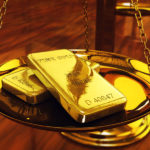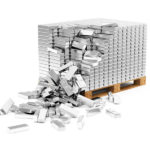WGC - Gold Demand Trends Q2 2019
(August 1, 2019)
Central bank buying and ETF inflows boosted H1 demand
Gold demand was 1,123t in Q2, up 8% y-o-y. H1 demand jumped to a three-year high of 2,181.7t, largely due to record-breaking central bank purchases.
Central bank buying and healthy ETF inflows were the driving forces behind gold demand throughout the first half of 2019. Growth in H1 jewelry demand was largely the product of a more positive environment for Indian consumers. Shifts in bar and coin investment were very much price-related: as the gold price powered its way to multi-year highs, profit-taking kicked in and retail investment all but dried up. The technology sector reduced its usage of gold due to challenging global conditions, although the outlook is for this element of demand to establish something of a floor over coming quarters. Solid growth in both mine production and recycling fed into a 2% increase in total H1 gold supply.
H1 gold demand boosted to a three-year high by record central bank buying
Gold demand for H1 hit a three-year high, boosted by record central bank buying
Global official gold reserves continued to grow at a rapid pace, as a diverse range of countries added to their holdings.
Healthy Q2 inflows (+67t) were largely directed towards European-listed ETFs, which grew to a record high of 1,184t.
US$ gold prices breached US$1,400/oz for the first time since 2013, while local prices in some markets reached record highs.
Highlights
Central banks bought 224.4t of gold in Q2 2019. This took H1 buying to 374.1t – the largest net H1 increase in global gold reserves in our 19-year quarterly data series. Buying was again spread across a diverse range of – largely emerging market – countries.
Holdings of gold-backed ETFs grew 67.2t in Q2 to a six-year high of 2,548t. The main factors driving inflows into the sector were continued geopolitical instability, expectation of lower interest rates, and the rallying gold price in June.
A strong recovery in India’s jewelry market pushed demand in Q2 up 12% to 168.8t. A busy wedding season and healthy festival sales boosted demand, before the June price rise brought it to a virtual standstill. Indian demand drove global jewelry demand 2% higher y-o-y to 531.7t.
Bar and coin investment in Q2 sank 12% to 218.6t. Combined with the soft Q1 number, the H1 total ended at a ten-year low of 476.9t. A 29% y-o-y drop in China accounted for much of the global Q2 decline.
Gold supply grew 6% in Q2 to 1,186.7t. A record 882.6t for Q2 gold mine production and a 9% jump in recycling to 314.6t – boosted by the sharp June gold price rally – led the growth in supply. H1 supply reached 2,323.9t – the highest since 2016.
Gold prices shot to multi-year highs. The gold price broke through US$1,400/oz for the first time since 2013. Among the factors driving this rally were expectations of lower interest rates and political uncertainty, with further support coming from strong central bank buying.
Central Banks and other institutions
H1 central bank demand at highest level since becoming net buyers in 2010
- Central bank net purchases rose 47% y-o-y to 224.4t in Q2
- H1 2019 net purchases totalled 374.1t, the highest level since becoming net buyers in 2010
- Poland was the largest purchaser in the quarter; reserves grew by 100t (+77%)
| Tonnes | Q2'18 | Q2'19 | YoY | |
| Central banks & others | 152.8 | 224.4 | 47% |
Central bank net purchases totaled 224.4t in Q2, 47% higher y-o-y. Total net purchases for the first six months of 2019 rose to 374.1t: 57% higher y-o-y, and the highest level of y-t-d demand since central banks became net purchasers (on an annual basis) in 2010. Buying momentum has continued strongly from last year – 2018 saw the highest level of annual purchases in 50 years – and is a clear indication of the central banking community’s mind-set towards gold.
Highest level of H1 purchases since central banks became net buyers
Highest level of H1 purchases since central banks became net buyers
Ongoing global struggles remain a headache for reserve managers. Sluggishness, exacerbated by trade and geopolitical tensions, continued to cast a dark cloud over the global economy. This was reflected in volatile financial markets during the quarter. Central banks, like other investors, sought safety in gold as they looked to protect themselves in the face of many looming risks.
Central bank demand still geographically diverse. Nine central banks increased their gold reserves by at least a tonne in the first half of 2019. This continues the trend seen over recent quarters, where demand has been spread amongst a larger number of – primarily emerging market – central banks.
Poland’s giant purchase bumped Russia into a Q2 second place. Poland, which had previously boosted its gold reserves by 25.7t in 2018, followed this up with a whopping 100t purchase in Q2. This is the highest quarterly purchase by a single central bank since India bought 200t from the IMF in November 2009. National Bank of Poland President Professor Adam Glapiński indicated that this purchase was strategic, with the intention of further safeguarding the financial security of the country.
Russian gold reserves rose by 38.7t in Q2, bringing y-t-d net purchases to 94t, compared with 105.3t in H1 2018. Gold reserves stood at 2,207t at the end of June, equal to 19% of total reserves. In May, the central bank discounted its purchase price to encourage domestic producers to export more gold. Governor, Elvira Nabiullina stated: “We introduced discounts for the purchase of gold because we saw that vendors were selling gold mainly to the central bank,” and “The discount aligns domestic conditions with external ones and motivates gold producers to … export too”. This corresponds to a slight dip in purchases by the central bank towards the end of the quarter, but the bank clarified: “It wasn’t a special decision on our part to reduce gold purchases”.
Chinese gold reserves grew by 74t in H1. The volume of monthly net purchases increased marginally in Q2, bringing the monthly average for 2019 to 12.3t (11t in Q1). Turkey continued to increase gold reserves, up 60.6t in H1, while Kazakhstan added 24.9t to its gold reserves over the same period. Other central banks to increase their gold reserves by at least a tonne during H1 were: India (17.7t), Ecuador (10.6t), Colombia (6.1t) and the Kyrgyz Republic (2t).
The Central Bank of the Philippines announced at the end of May that it would begin purchasing gold from local small-scale miners. It is anticipated that buying could reach one million ounces a year, significantly higher than the current 20,000-30,000oz.
Selling remains a fraction of buying. Over the first six months, declared gross sales amounted to 7.2t, just 2% of gross purchases.
But during Q2 more news emerged regarding the swap agreement involving Venezuelan gold reserves. It was reported in April that Venezuela was deemed to have defaulted on a gold swap with Citibank and Deutsche Bank. This meant the banks took control of the US$1.4bn of gold (~28t) that underpinned the swap.
Our treatment of swap agreements is that they are deemed a sale if the agreement ends in default (i.e. the gold is not returned as originally planned). Therefore, the termination of the swap agreement in Q2 is treated as a sale by Venezuela in our figures. And this is not the first Venezuelan gold swap agreement we have recorded as a sale. In Q4 2017, a swap for approximately 45t ended in default, as did another for around 42t in Q1 2019. The precipitous decline of Venezuelan gold reserves remains closely watched by both market participants and international governments/authorities.
Elsewhere, and as we’ve seen over many recent quarters, declared gross sales by central banks are few and far between. Only four other banks reduced gold reserves by a tonne or more in H1: Uzbekistan (-3.7t), Germany (-3t), Tajikistan (-1.8t) and Mongolia (-1.7t) – with the former relating to a long-established coin-minting program.
Investment
Total investment 1% firmer y-o-y, as healthy ETF inflows counterbalanced a 12% drop in bar and coin demand.
- Holdings in global gold-backed ETFs grew by 67.2t in Q2, to reach 2,548t
- UK-listed ETFs attracted the greatest inflows in Q2, due to Brexit concerns and currency weakness
- Profit-taking erupted in June as the gold price reached key levels, driving bar and coin investment down to a decade low.
| Tonnes | Q2'18 | Q2'19 | YoY | |
| Investment | 282.0 | 285.8 | 1% | |
| Bar & coin | 248.2 | 218.6 | -12% | |
| India | 39.3 | 44.5 | 13% | |
| China | 69.5 | 49.5 | -29% | |
| Gold-backed ETFs | 33.8 | 67.2 | 99% |
ETFs
Investors added 67.2t to their holdings of gold-backed ETFs in Q2, taking total holdings to a six-year high of 2,548t. Strong inflows in June (+126.7t) outweighed April’s sizable outflows (-57.2t).
In terms of US dollar value, AUM in the sector grew to US$115.4bn – the highest since April 2013 – on a combination of net inflows and a higher gold price. Net inflows throughout H1 reached 107.5t, compared with 60.9t in H1 2018.
Geopolitical uncertainty, dovish monetary policy commentary by central banks, and a rising gold price were among the key factors that drove investors to increase their holdings.
European-listed products have absorbed the bulk of the inflows so far in 2019. Holdings of gold-backed ETFs in Europe grew by 87.2t over the first half-year, with 67.2t of that growth occurring in Q2.
UK-listed funds led the way in Q2: around 75% of all global inflows during the quarter were directed towards these products. Investors sought the safe haven of gold amid the uncertainty surrounding Brexit and the leadership battle that followed Theresa May’s resignation as Prime Minister. The sharp drop in the value of the pound also fueled inflows during the quarter as the UK’s growth prospects were cut following repeated failures in Brexit negotiations.
German-based funds also saw decent inflows: the US-China trade war weighed heavily on investors’ minds as they sought the relative safety of gold. The German auto sector is vulnerable to continued global trade uncertainty, as highlighted by recent profit warnings rom car maker Daimler AG and supplier to the auto sector, BASF. Anecdotal evidence suggests that this vulnerability was a factor driving inflows into gold-backed ETFs.
And gold investors had the added incentive of very low rates: the yield on 10-year German government bonds reached historic lows of -0.33% in June. Such record lows enhanced gold’s investment appeal: holdings in UK- and German-listed funds increased by 11% (to a record 554.1t) and 2% (to 338.5t), respectively, in Q2.
US funds grew by a modest 4.8t in Q2, as hefty inflows in June reversed prior outflows. Combined outflows of 60.2t in April and May gave way to strong growth in June, when North American funds added 65t. The 9% rise in the US dollar gold price during the month likely attracted momentum investors, as seen by strong inflows into the most liquid funds. Overall, North American inflows were supported by continued tension between the US and various trade partners, as well as expectations of lower interest rates, as the Federal Reserve signaled a more dovish stance – with up to three rate cuts now being priced in throughout the remainder of 2019.
Elsewhere, gold-backed ETFs saw another quarter of very modest outflows. Asian-listed funds lost 4.1t; much of this was due to a 5.4t outflow from China’s Huaan Yifu fund. Total H1 outflows of 9t from Chinese funds have – we believe – been a function of profit taking and a shift to riskier assets in the region. Gold-backed ETFs in other regions lost 0.5t. This segment remains small, with aggregate holdings of just 31t.
Bar and coin
The retail investment market was relatively soft in Q2 2019. It experienced its third consecutive q-o-q decline and demand fell 12% y-o-y to 218.6t; China accounted for around two-thirds of the drop. Global H1 demand of 476.9t was at its lowest level since 2009.
H1 bar and coin demand fall to its lowest level since 2009 due to profit-taking
H1 bar and coin demand fall to its lowest level since 2009 due to profit-taking
After a steady start to the quarter, retail investment stalled in June as the gold price rallied. Some investors sold a portion of their investments to realize profits, while others sat on the side-lines in the belief that the rally would be short-lived and that they could enter the market at a lower price.
Gold market giants diverged in the second quarter. In China, Q2 bar and coin demand fell to 49.5t, its lowest level since Q3 2016, as investor worries faded and the gold price rallied. Currency concerns – which have supported gold investment over the past 18 months – eased in May as Pan Gongsheng, Vice-Governor of the People’s Bank of China, pledged to keep the exchange rate stable. And in June the local gold price rose sharply to a six-and-a-half year high of 322yuan/g. Having witnessed the Chinese Damas’ rush to gold in 2013, and their subsequent losses, Chinese investors decided to sit back and wait for a less volatile price environment. These factors combined to depress fresh purchases and boost investor sales.
In contrast to the soft retail investment demand, speculative trading activity on the Shanghai Gold Exchange shot through the roof. In June, trading volumes of the Au(T+D) margin-traded gold contract hit 2,062t, the second highest level on record.
India, on the other hand, was one of the few bright spots this quarter. Bar and coin demand rose 13% y-o-y to reach 44.5t in Q2, a five-year high for second quarter demand. Akshaya Tritiya, the annual Hindu and Jain festival, supported demand in May, with the volume of gold sold soaring some 20-25% y-o-y during the festival. Industry contacts estimated that gold investment products accounted for around 60% of these sales. Investor liquidations were limited despite the sharp rise in the rupee gold price, which finished the quarter at Rs34,006/10g, close to the record high of Rs34,500/10g set in August 2013, as investors felt the rally had further to run.
Demand in the Middle East was down 27% to 15.7t, largely due to a drop in Iranian demand, which fell 31% y-o-y. This was the first y-o-y decline in Iranian bar and coin demand since 2016. The weak rial and the eye-wateringly high local gold price, which averaged IRR6,050,110/g in May, pushed gold out of reach for many investors and encouraged others to take profits.
Retail investment in Turkey fell 15% y-o-y to 9.9t. The local gold price was elevated throughout the quarter and hit a record high of TRY 263,893/g on 25 June, prompting some investors to take profits on a portion of their gold holdings.
In East Asia, demand in Thailand dropped to 12.9t, its lowest quarterly level since Q4 2010. This partly reflects a shift away from physical gold to a FX-hedged cash-settled contract traded on the Thai Stock Exchange. This contract was launched in Q4 2018 and has proved increasingly popular with Thailand’s gold traders.
In Vietnam, retail investment was steady at 9t. The rally in the US dollar gold price drew out some sales – pushing the Vietnamese wholesale gold market to a discount against the global spot price – and gave rise to unofficial flows out of the country.
Retail demand in the US remained weak. Q2 demand was just 3t, taking H1 demand to 9.8t – the lowest level since 2007. Q2 bullion coin sales from the US Mint fell to 19,000oz, the lowest level since Q3 2006. This market has been struggling for some time, with many traditional gold investors focused on America’s healthy economic growth, low unemployment, and continued wage growth. The gold price rally in June triggered selling by some investors, and coin premiums in the secondary market fell to their lowest level since before the global financial crisis, spurring gold exports from the US to Germany.
Buoyant US economy has hit US Eagle bullion coin sales hard
Buoyant US economy has hit US Eagle sales hard
Note: chart shows the total volume of gold sold (includes one ounce, half ounce, quarter ounce and tenth ounce Eagle coins).
Although the scale of retail disinvestment in response to the price rally was less pronounced in Europe, demand was weak nonetheless. At 32.4t in Q2, it stood at its lowest level since 2008. And while German demand was marginally firmer (up 1% y-o-y) the increase is in comparison to a low base (Q2 2018 was the third lowest quarter since 2010). Despite this weakness, it appears that television marketing campaigns have fuelled the appetite for small gold bars (between 1g-3g) amongst the mass retail market.
Supply
Total Q2 supply pushed 6% higher by record mine production and higher recycling, contributing to 2% growth in H1.
- Mine production up 2% y-o-y in Q2; highest second quarter on record
- Global hedge book fell by 10.5t in Q2 2019, now estimated at 209t at the end of June
- Recycled gold boosted 9% y-o-y by higher gold prices towards the end of the quarter.
| Tonnes | Q2'18 | Q2'19 | YoY | |
| Total supply | 1,121.3 | 1,186.7 | 6% | |
| Mine production | 869.2 | 882.6 | 2% | |
| Net producer hedging | -37.7 | -10.5 | - | |
| Recycled gold | 289.8 | 314.6 | 9% |
Mine production
Global mine production grew 2% y-o-y in Q2, reaching 882.6t. This is a record level of global output for a second quarter and follows on from a Q1 record of 847.5t. Total H1 mine production now stands at 1,730.2t, 1.1% higher than H1 2018. As we noted in our previous Gold Demand Trends report, this represents a very strong start to the year.
Some key producing nations saw significant gains in Q2. Canadian and Russian gold output saw a 9% increase y-o-y as both benefited from new projects. In Canada, the continued ramp-up of Brucejack, Rainy River and Moose River, as well as Meliadine coming online, boosted quarterly production. In Russia, the ramp-up of the Natalka project – in addition to increases from several other mines, particularly in the eastern region of the country – pushed aggregate output higher. The US saw a similar increase in gold production (+9% y-o-y). Higher output from Carlin and Cripple Creek helped offset lower expected output from Goldstrike and Cortez. Australian gold production (+6%) was boosted by stronger output from several mines, while Kazakhstan (+18%) benefited from the continued ramp-up of the Kyzyl project. In West Africa, Ghana – the continent’s largest producing nation – saw a 6% y-o-y increase in production, primarily from Ahafo and Akyem.
China, South Africa and Indonesia saw continued declines. Chinese gold production registered another quarter of y-o-y declines. National output fell 4% y-o-y as the stricter environmental regulations imposed in 2017 continued to impact the industry – albeit to a lesser degree. South African production fell 12% y-o-y, disrupted by industrial action. Output from Beatrix, Kloof and Driefontein was cut significantly due to strikes that began in November 2018 and only drew to a close at the end of April. In Indonesia, national production fell by 48%. At Grasberg, the exhaustion of higher grades in the final phase of the open pit and the subsequent switch to underground mining continued to depress volumes relative to 2018. Batu Hijau remains constrained by Phase 7 open pit expansion, as well as by copper concentration export limits and the lack of local smelting capacity.
Weaker currencies help improve miners’ margins. Weaker producer currencies helped pushed non-US dollar costs down, boosting miners’ coffers in key mining nations such as South Africa, China, Australia, Russia and Ghana. An increasing gold price – especially in key producer currencies – was still more advantageous, pushing margins higher. This puts the industry in a reasonably healthy position.
Net producer hedging
Net de-hedging by gold miners in Q2 reduced the global hedge book by 10.5t: it was estimated to stand at 209t at the end of June. Y-t-d, net de-hedging totalled 8.3t.
Modest levels of hedging despite the higher gold price. Q2 was marked by an increasing gold price and weakening producer currencies. As a result, the gold price in a range of currencies hit multi-year – and in some cases record – highs.
The gold price rally towards the end of Q2 boosted supply (index 01/01/19=100)
The gold price rally towards the end of Q2 boosted supply (index 01/01/19=100)
Australian miners have been the most active, dictating the size of the global hedge book over the last year. Record local prices – which breached A$2,000/oz for the first time - tempted some into adding fresh positions.1 For example, Resolute Mining added a further 30koz to their existing hedge book during the quarter. Elsewhere, rising gold prices have yet to draw out significant levels of hedging. Fresh positions continue to be sporadic and tactical.
Recycled gold
Recycled gold supply totalled 314.6t in Q2, 9% higher than the same period last year. The strong gold performance so far in 2019, especially in Q2 when it broke through the psychological US$1,350/oz level, encouraged a wave of selling as some consumers looked to lock in profits. Y-t-d recycled gold totalled 602t, 7% higher than the same period in 2018 and the highest H1 since 2016 when a huge rally in the gold price prompted significant selling back.
Q2 saw the highest level of recycled gold since 2016
Q2 saw the highest level of recycled gold since 2016
While the rise in recycling may be unsurprising given the gold price performance in Q2, the response was far from uniform. In western markets – North America and Europe – higher recycling volumes in June were responsible for much of the increase over the quarter. The supply of recycled gold in April and May was relatively subdued, which meant the boost in June helped achieve a modest overall increase in Q2.
In the Middle East, Iran again saw robust absolute levels of recycling, modestly higher y-o-y. The volatile USD/rial exchange rate helped support local gold prices in May – as international prices fell – but then countered the gold price rally in June. Turkey, on the other hand, saw much more modest levels of recycling despite higher prices. The reason for this was price expectations amongst consumers, who generally believed that the rally had further to run and so waited to sell at higher prices. The ongoing normalization of Egypt’s recycling market – following the surge in 2016 – meant another y-o-y decline.
In China, recycled gold supply in Q2 was noticeably higher y-o-y. While April and May were quiet, consumers were enticed to sell their gold through promotions offered by jewellers as the price rose in June. And, higher volumes may also have been helped by recent advances made in China’s gold recycling market. India too saw more recycling as the gold price rose above Rs32,000/10g in June. Elsewhere in Asia though, the response to the price increase was far more muted.






